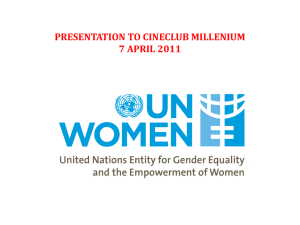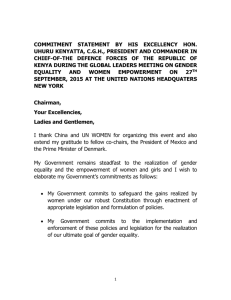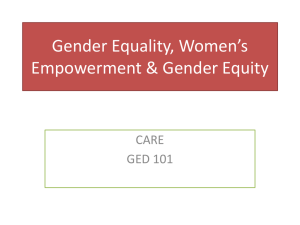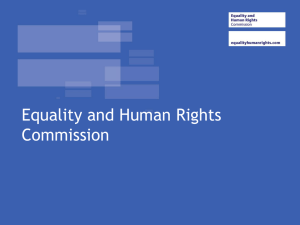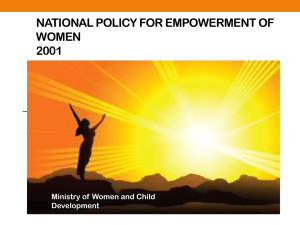Follow the link for details
advertisement
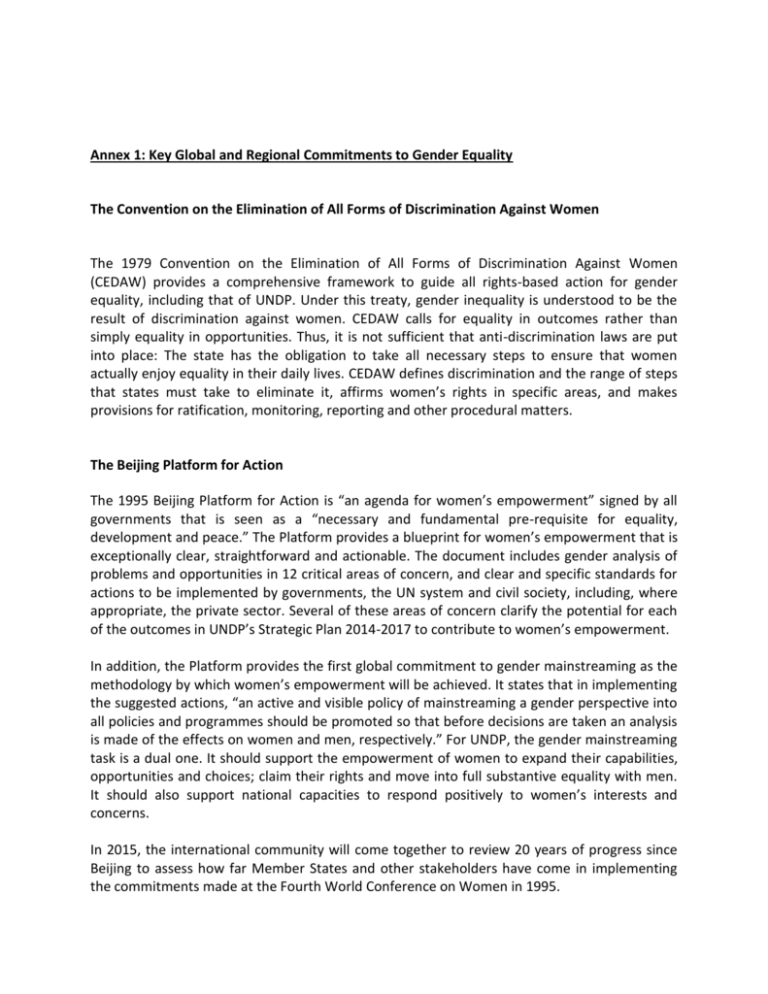
Annex 1: Key Global and Regional Commitments to Gender Equality The Convention on the Elimination of All Forms of Discrimination Against Women The 1979 Convention on the Elimination of All Forms of Discrimination Against Women (CEDAW) provides a comprehensive framework to guide all rights-based action for gender equality, including that of UNDP. Under this treaty, gender inequality is understood to be the result of discrimination against women. CEDAW calls for equality in outcomes rather than simply equality in opportunities. Thus, it is not sufficient that anti-discrimination laws are put into place: The state has the obligation to take all necessary steps to ensure that women actually enjoy equality in their daily lives. CEDAW defines discrimination and the range of steps that states must take to eliminate it, affirms women’s rights in specific areas, and makes provisions for ratification, monitoring, reporting and other procedural matters. The Beijing Platform for Action The 1995 Beijing Platform for Action is “an agenda for women’s empowerment” signed by all governments that is seen as a “necessary and fundamental pre-requisite for equality, development and peace.” The Platform provides a blueprint for women’s empowerment that is exceptionally clear, straightforward and actionable. The document includes gender analysis of problems and opportunities in 12 critical areas of concern, and clear and specific standards for actions to be implemented by governments, the UN system and civil society, including, where appropriate, the private sector. Several of these areas of concern clarify the potential for each of the outcomes in UNDP’s Strategic Plan 2014-2017 to contribute to women’s empowerment. In addition, the Platform provides the first global commitment to gender mainstreaming as the methodology by which women’s empowerment will be achieved. It states that in implementing the suggested actions, “an active and visible policy of mainstreaming a gender perspective into all policies and programmes should be promoted so that before decisions are taken an analysis is made of the effects on women and men, respectively.” For UNDP, the gender mainstreaming task is a dual one. It should support the empowerment of women to expand their capabilities, opportunities and choices; claim their rights and move into full substantive equality with men. It should also support national capacities to respond positively to women’s interests and concerns. In 2015, the international community will come together to review 20 years of progress since Beijing to assess how far Member States and other stakeholders have come in implementing the commitments made at the Fourth World Conference on Women in 1995. The Millennium Development Goals The MDGs, in effect, consolidated previous agreements, including those on women’s rights, women’s empowerment and gender equality, into a single set of core goals, targets and benchmarks for the development community. The Millennium Declaration from which they were drawn took a clear position, which has since been elaborated in multiple documents, that gender equality is both a right in itself and a driver of development. The MDGs reflected that through a specific goal (MDG 3), although the promotion of gender equality and women’s empowerment as a condition for the achievement of the other goals was not well-reflected. The development community is in the process of reviewing lessons learned and progress toward the achievement of the MDGs with a view to accelerating progress before the 2015 MDG deadline and elaborating on a post 2015 development agenda. The May 2013 report to the UN Secretary-General of the High-Level Panel of Eminent Persons on the post 2015 Development Agenda underscored that “women who are safe, healthy, educated and fully empowered to realise their full potential transform their families, their communities, their economies and their societies. We must create the conditions so they can do so.” This was reflected in the subsequent SG’s report which underscored the continued challenges faced by women and girls, the need to challenge discrimination against violence against women, and underscored the need for gender issues to cut across other goals and targets. UN Declaration on the Elimination of Violence Against Women The 1993 Declaration on the Elimination of Violence against Women is the first international human rights instrument to exclusively and explicitly address the issue of violence against women. It affirms that the phenomenon violates, impairs or nullifies women's human rights and their exercise of fundamental freedoms. The Declaration provides a definition of gender-based abuse, calling it "any act of gender-based violence that results in, or is likely to result in, physical, sexual or psychological harm or suffering to women, including threats of such acts, coercion or arbitrary deprivation of liberty, whether occurring in public or in private life. The Declaration further states that gender-based violence takes many different forms and is experienced in a range of crisis and non-crisis settings. It is deeply rooted in structural relationships of inequality between women and men. During conflict, systematic gender-based violence is often perpetrated and/or condoned by both state and non-state actors. It thrives on impunity both in times of war and in times of peace. The International Conference on Population and Development The 1994 International Conference on Population and Development (ICPD) in Cairo was a milestone in the history of population and development, as well as in the history of women's rights. ICPD delegates reached a consensus that the equality and empowerment of women is a global priority. This issue was approached not only from the perspective of universal human rights, but also as an essential step towards eradicating poverty and stabilizing population growth. A woman’s ability to access reproductive health and rights is a cornerstone of her empowerment. It is also critical to sustainable development. Women, Peace and Security Framework and Commitments The UN’s guiding documents for women, peace and security are Security Council Resolutions 1325 (2000) and 1889 (2009) on women, peace and security and 1820 (2008) and 1888 (2009) on sexual violence in armed conflict. These resolutions have laid the foundation for the efforts of the UN community to expand the role of women in leadership positions in every aspect of prevention and resolution of conflicts, including peacekeeping and peacebuilding efforts, and to improve protection of women and girls within a framework of rule of law and respect for human rights. UN Framework Convention for Climate Change The Cancun Agreements emerging out of the UN Framework for Climate Change COP-16 in 2010 were the first global climate change policy to include multiple references to gender equality. Since then, more gains have been made to foster women’s participation in negotiations and entrench gender equality in UNFCC outcome documents in such areas as guidelines for national adaptation plans, mitigation, capacity building and technology and REDD+ safeguards. Gender considerations were also integrated in Green Climate Fund, the Adaptation Fund and Climate Investment Funds. At COP-18 in Doha in 2012, a decision was adopted promoting gender balance and improving the participation of women in UNFCCC negotiations and in the representation of Parties in bodies established pursuant to the Convention or the Kyoto Protocol. The decision includes calls mechanisms to track progress toward gender balance; the inclusion of gender equality and climate change as a standing item on future COP agendas; organization of a workshop on gender balance in the UNFCC process at COP-19; and gender-sensitive climate policy and capacity-building activities to promote the greater participation of women in the UNFCCC process. Aid Effectiveness Commitments Policies on gender equality must be matched by the needed resources to implement them. The importance of gender equality in resource allocation was underscored in the 2008 Accra Agenda for Action (AAA), building on the 2005 Paris Declaration on Aid Effectiveness. Through the Accra Agenda for Action, developing countries and donors commit to ensure that their respective development policies and programmes are designed and implemented in ways consistent with their agreed international commitments on gender equality, human rights, disability and environmental sustainability. The Busan Partnership for Effective Development Cooperation endorsed in 2011 recognises that gender equality and women’s empowerment are critical to achieving development results and agreed to accelerate and deepen efforts to (1) improve information systems with disaggregating data by sex; (2) integrate targets for gender equality and women’s empowerment in accountability mechanisms; and (3) address gender equality and women’s empowerment in all aspects of development efforts, including peacebuilding and statebuilding. Other regional commitments Numerous regional commitments also underscore the importance of and uphold gender equality, including the Protocol on the Rights of Women in Africa, adopted in 2003 by the African Union, the 1994 Inter-American Convention on the Prevention, Punishment and Eradication of Violence against Women (the Convention of Belem Do Para), and the 2011 European Convention on Preventing Violence against Women and Domestic Violence.
